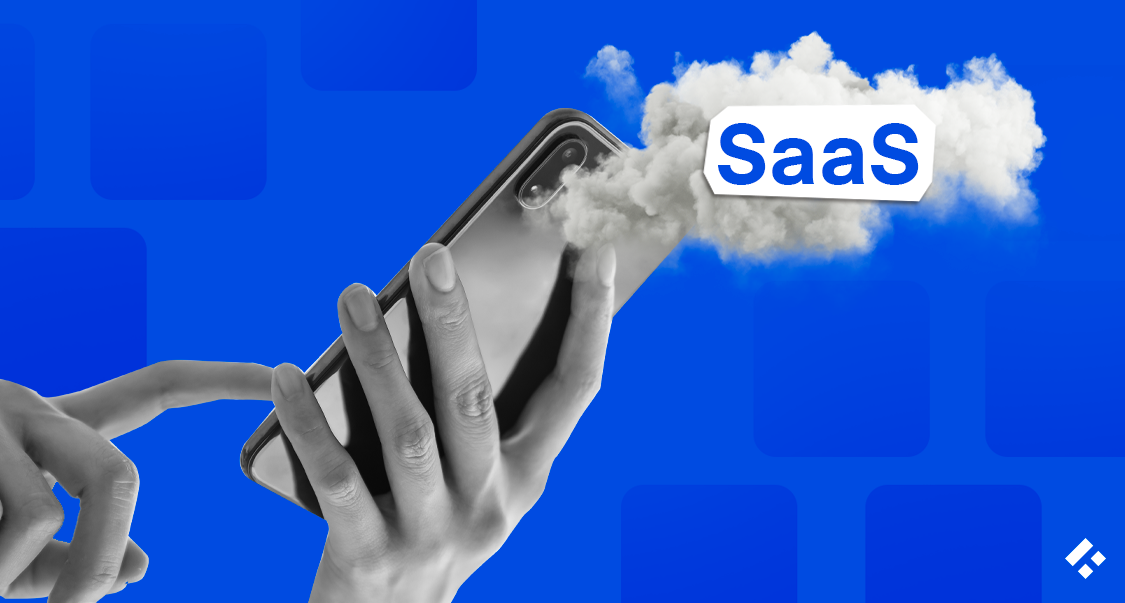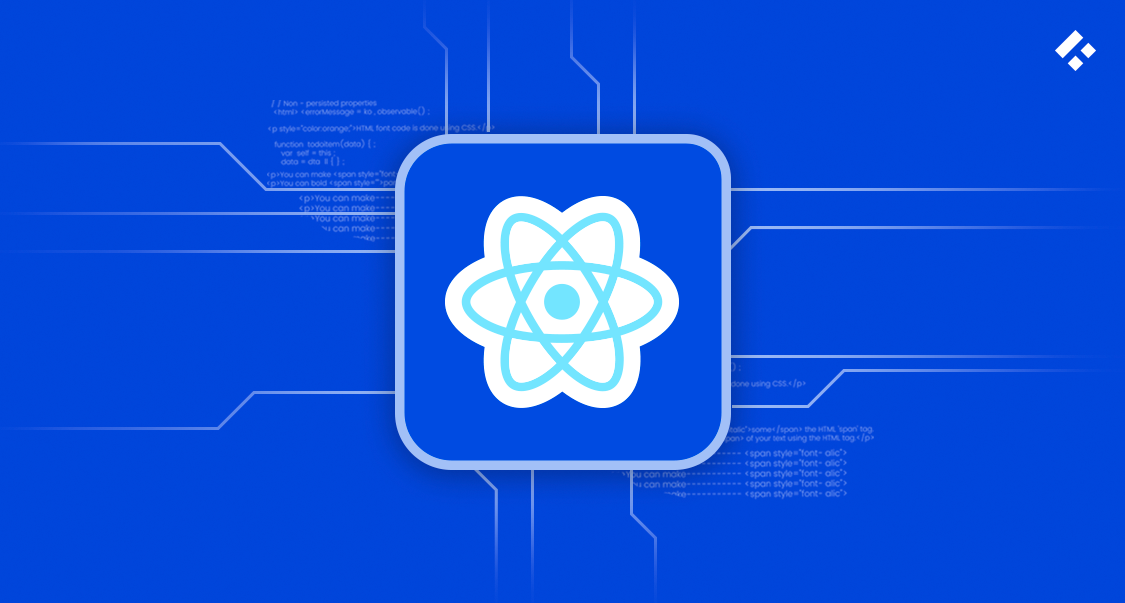SaaS apps are the most common form of software delivery in the modern day. When was the last time you actually bought a product, installed it, and worked from there?
While some users express frustration at the SaaS framework, there is no denying that the benefits of SaaS, especially to development companies, and the advancements in cloud computing, are only encouraging growth in the industry. Now, more than 80% of companies use at least one SaaS platform to conduct their business.
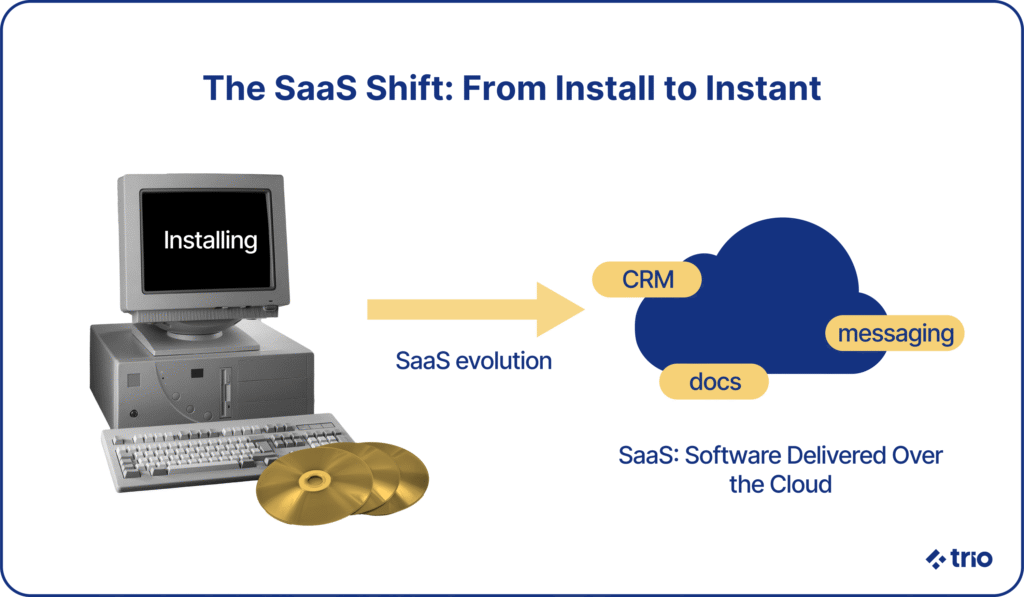
SaaS application development (Software as a Service) is when you develop cloud-based software that is made available to users over the internet.
If you are building software applications, it may be worth your while to consider a SaaS model. In this article, we’ll cover everything you need to know about developing SaaS applications, including the costs, tools, and specialized skills you would need to consider for a cloud-based software delivery model.
If you are looking for a SaaS application development company to bring your vision to life, you are in the right place. At Trio, we have a wide variety of developers on hand, including those with experience in the SaaS development cycle.
This means you can rest easy knowing you have an expert on hand who has the industry knowledge to code quickly and efficiently, creating high-quality code and setting you up for long-term success.
What is SaaS and SaaS Application Development?
As mentioned already, SaaS is a model that companies use to make their products available on the internet.
Usually, this means that the SaaS provider owns the software and implements subscription models to allow users access, rather than selling individual copies of the product.
No internal infrastructure or hardware is typically required.
SaaS application development refers to the process of designing and building a SaaS application, as well as everything required for long-term maintenance by the application service provider.
Key differences from traditional software
The most significant difference between SaaS apps and traditional apps includes:
- Deployment: You need to install traditional software, sometimes from a disk or other means, and SaaS applications are just accessed via the cloud, no installation required
- Cost Structure: SaaS can make use of subscriptions, which makes them more inclusive upfront due to slightly lower costs, but challenging to utilize long-term for some.
- Maintenance: SaaS providers update and maintain the software in real time, rolling out automated changes that make sure users are always using the latest version.
- Accessibility: Users can access SaaS apps from anywhere, usually on limitless devices, as long as they have an internet connection.
Examples of SaaS Applications
While the number of SaaS applications available is incredible at the moment, a couple of examples stand out.
Salesforce is a SaaS CRM (customer relationship management) platform. Most companies, even we at Trio, will make use of tools like this to manage customer data, automate processes, and track KPIs that allow us to garner insights on our marketing and sales processes, and where there may be an issue or opportunity for improvement.
Slack is one of the many communication apps on the market at the moment. It is generally used as a desktop app, and allows teams to message one another in real time, share files instantly, and even integrates with other common SaaS apps.
Then, there are platforms like Google Workspace and Microsoft 365, which take care of document creation and collaboration.
The field is quite competitive, but thanks to the lower initial costs that come with using a SaaS product, many people are able to try several options before settling on one that works best for them.
SaaS Architecture
There are some components in SaaS architecture that ensure SaaS applications are highly scalable and allow you to adapt to changing requirements easily and efficiently.
Multi-tenancy, or when a single application can serve more than one SaaS customer, lets many different users make use of your application without needing to worry about others seeing their data. In other words, their privacy is maintained.
Privacy and security, usually in the form of a variety of robust encryption and user authentication measures, are incredibly important for any apps, but especially those that run in web browsers or require connectivity.
This multi-tenancy goes hand-in-hand with scalability, where the number of resources needs to automatically adjust to serve different numbers of users. You could try to cater to the upper end of your expected user numbers, but doing so all the time would be inefficient and would result in unnecessary costs related to resources like cloud infrastructure.
Instead, you want to start small but be able to scale later.
High availability can also be achieved by incorporating redundant systems to ensure that your app stays operable, even in situations where something may go wrong with some part of your app throughout the development and maintenance process.
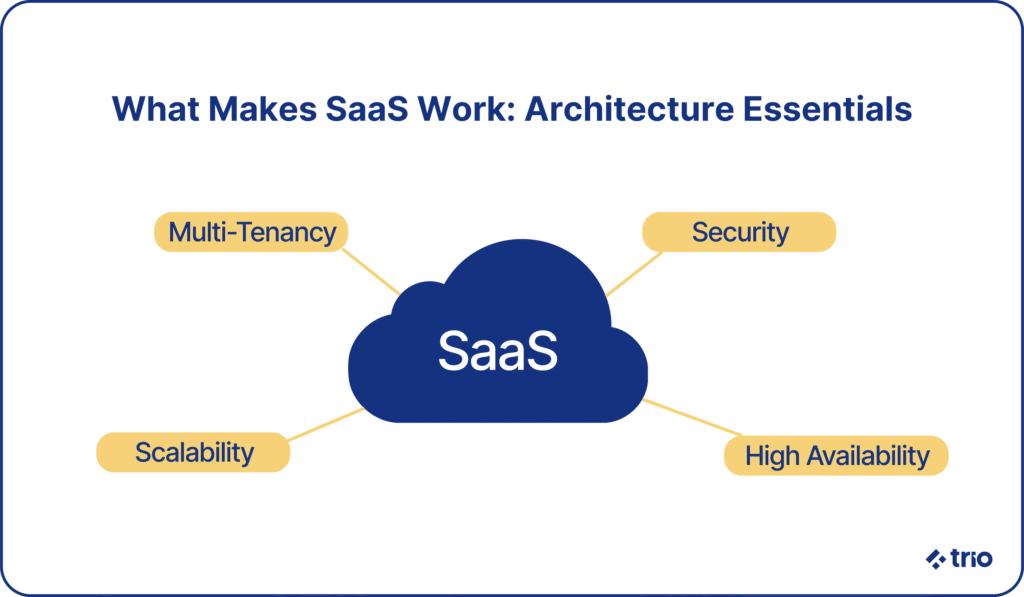
The SaaS App Development Process: Step-by-Step
Now that we have covered the basics of SaaS applications, let’s go over the steps to develop one. Each company may have a slightly different approach, but having an understanding of the general process will give you a better idea of what you can expect and will help you choose the right partner for your custom SaaS application.
Step 1: Market research and needs assessment
Before you can start doing anything, you need to do some market research. A big part of this research involves figuring out what your target user is and what they need from a SaaS vendor.
You will also get an idea of the SaaS market as a whole, and perhaps even identify certain software and hardware opportunities that you could take advantage of.
The more thorough your research, the higher the chances of your app being successful.
Having an experienced developer on your team who has practical experience with this kind of development and the SaaS business model in general can be highly beneficial. These developers, like the ones available at Trio, are able to give you first-hand insights that you can incorporate into your research.
Step 2: Hypothesis testing and validation
Once you’ve got an idea of the types of SaaS applications that you wish to develop, you can test them or validate them. We highly recommend this step as it allows you to make adjustments before completing the entire development cycle.
A great way to test your concept is through a prototype or a mockup created using a tool like Figma that you can market to a select group of users to gather feedback.
Step 3: Monetization strategy and pricing model
Once you have built your SaaS solution, you will need to monetize it in some way. There are various revenue models you could consider, including:
- Subscription
- Freemium
- Pay-per-use
You need to make sure that whatever model you decide to go with is realistic for your target user, and will bring in a sustainable income stream that you can allocate towards things like software maintenance or take as profit.
Doing research and deciding on this from the get-go will ensure you account for any code variations and avoid delays later.
Step 4: Choosing tech stack and architecture
Decide on what technologies and development tools are going to work best. You should not only explore secure and scalable frameworks, programming languages, and cloud providers, but also consider adopting things like microservices or serverless architecture.
Further considerations that will play a role in your decision will be the skills of your existing development team, or the availability and cost of any new developers that you might need to hire.
Some of the most popular choices we’ve noticed being used for various SaaS applications include React and Angular on the frontend and Node.js and Django for the backend. The most popular cloud providers that you can consider include AWS, Azure, and Google Cloud.
Step 5: MVP development and iteration
Once you’ve decided on all the details and your concept has been validated, you can move on to coding. Instead of diving into the entire project straight away, get an MVP (minimum viable product) with only your core features finished first.
You can release this MVP to get your marketing process started. This will not only mean that you will start making money sooner, but it will also allow you to incorporate more user feedback.
Step 6: Testing
Basic testing should occur throughout the coding process to minimize the likelihood of big mistakes slipping through. When you test regularly, it is also far easier to find the issues than it would be if you tested an entire code base at the end of the development process.
Quality assurance (QA) developers can be very useful. It might be worthwhile getting one on your team, even if it is just in the form of staff augmentation on a temporary basis.
Comprehensive testing goes beyond making sure you have no bugs, though. You should be testing for functionality, compliance with any regulations you may fall under, and even performance under load. UX experts can also help you test and optimize user-friendliness and accessibility.
Step 7: Deployment and scaling
Launching your app is the penultimate step. You’ll need to keep an eye on the app in the form of monitoring systems, and make sure that everything works smoothly in real-world conditions.
You’ll also start scaling in user base and overall app offering as more people start trying out your app, or you start to add additional features.
Step 8: Post-launch maintenance and continuous improvement
Maintenance is critical. Even if nothing changes in your own app, the world around you is changing in terms of both hardware and software, and you will need to adapt your app accordingly.
This means updating features, fixing new bugs, minimizing usage, and improving the product to match changing expectations.
Failing to do so means that your app becomes either redundant or useless.
Advantages of SaaS Products
There are many benefits of SaaS applications, including:
- Scalability and flexibility
- Cost-effectiveness and pay-as-you-go models
- Accessibility and remote workforce support
- Regular revenue and a broader customer base
- Continuous updates and easy maintenance
- Data analytics and business intelligence
When it comes to scalability and flexibility, resource allocation in SaaS is just impossible to match in traditional apps that require massive investments. These reduced upfront costs are further increased when you consider the fact that cloud providers often charge by usage, and this usage is directly linked to revenue in the form of subscription models.
Your potential users are also not as limited as they might be, as anyone with access to the internet can, in theory, access your app. Similarly, your developers can work remotely and contribute to the app from all over the world, allowing for easy updates and maintenance that can go out to all your clients immediately.
On top of all of that, most of the platforms you will make use of have existing tools for data collection and analysis, allowing you to make business decisions with as much information as possible.
Challenges in SaaS Development
It is incredibly important that you understand not only SaaS advantages but also the challenges you may encounter when developing a SaaS app. These challenges include:
- Choosing the right cloud services provider
- Ensuring security and privacy compliance
- Scalability and high availability
- Integration with third-party services
- Legal and compliance considerations (GDPR, CCPA)
- Balancing customization vs. standardization
Finding the right SaaS application development partner can be difficult, especially if this is your first application or your first time working with an external team. Even if they have all the technical skills, failing to implement security, encryption, and compliance measures means that you could run into some major issues later.
This is especially true if you consider the lack of geographic limitations of apps available on the internet.
Scaling can also be an issue if you haven’t set your application up for success with automated scaling, as the potential influx of users is massive. This could also affect integrations with other apps, which are already complex.
The wide variety of users, with different customization expectations, can complicate your updates, too, so you need to strike a balance between customization and a standardized codebase you can update and maintain reliably.
Cost of SaaS Software Development
There are many different factors that influence the cost of SaaS software development, including the number of features you desire, the technology you decide to use, the speed at which you want to code, and the size of your development team.
Typically, you can expect anywhere from $50,000 for a medium-sized app that can be competitive in today’s markets, to something well over $100,000 or even $200,000 for an enterprise-grade SaaS application with all the bells and whistles.
At Trio, we don’t offer one-size-fits-all solutions. Instead, we start with a consultation and then help you build the initial architecture or skeleton of your SaaS project if you don’t have one already. Based on this information and any other requirements, we are able to give you a detailed estimation of your total cost.
We are even able to give you information on some hidden costs like maintenance, updates, marketing, customer support, and security or data handling compliance.
Overall, it is important that you consider as much information on development costs and how you will be monetizing your app before you start as possible, so that you can understand if it is worth the risk.
Emerging Trends in SaaS Application Development
As with every other field in technology, SaaS application development is constantly changing as users and investors shift their expectations.
AI and machine learning are making big leaps in automation, personalization, and analytics, which most SaaS applications on the market have already started to make use of. Slack, for example, markets itself as an AI work management and productivity tool platform now, while Microsoft 365 has integrated features like Copilot.
Hyper-personalization has also been a rising trend in mobile and web app development, and SaaS applications are also expected to conform. Users want to be able to change their interfaces to suit their needs and preferences in an easy, user-friendly way.
Businesses are focusing on the quality of applications and would rather get a niche application specifically designed for their needs than spend the money on something general. There is also a general focus on security and transparency, which is expected as blockchain evolves and governments implement stricter regulations.
Finally, we’ve noticed a major emphasis on being able to scale quickly, usually through the use of serverless microservices architecture, but in the most sustainable, eco-friendly manner. The focus on green SaaS has likely risen alongside concerns about factors like energy and water consumption in large data centers that power complex processes like AI.
At Trio, we only hire the top 1% of developers, which means they are industry experts who are up to date on the latest trends and best practices. These developers not only write cost-effective code, but can also offer advice on where your plans might be improved, or where you may be in danger of common pitfalls.
If you are interested in Trio’s SaaS application development process, or you are ready connect with an outsourced development team to insividual developers to augment your own team, reach out to us to schedule a free consultation!
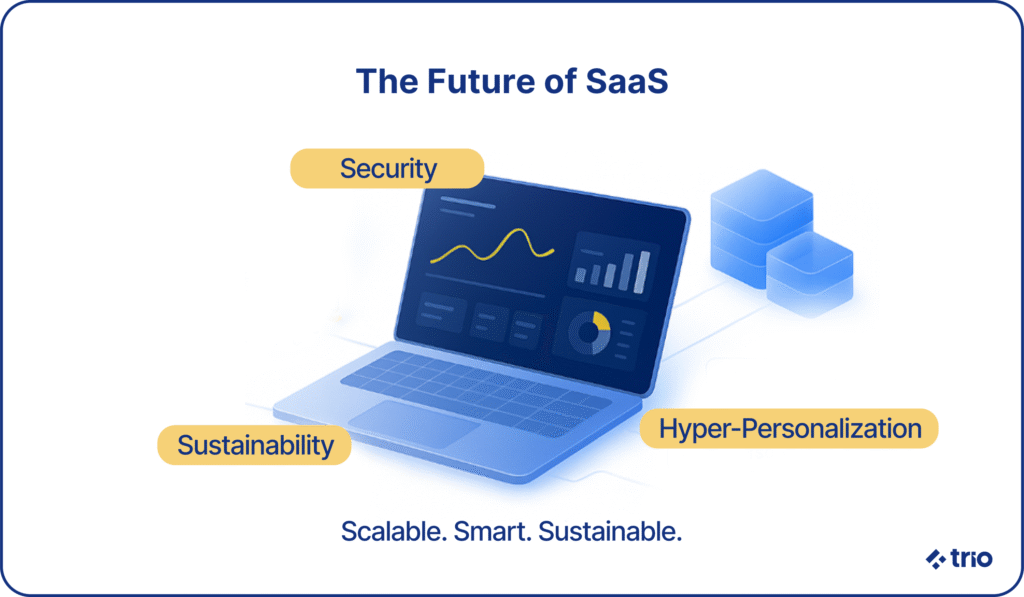
Frequently Asked Questions
What is SaaS?
SaaS refers to software generally offered online and available via a subscription model.
What’s the Difference Between SaaS and Other Software
The difference between SaaS and other software is that you generally subscribe to cloud-based SaaS, access it online and pay for access rights, other software you buy once and own, install it locally, and usually you don’t get free updates but need to buy newer software later.
Is SaaS development profitable?
Yes, SaaS development is profitable thanks to the recurring revenue (subscription models) and low distribution costs.
